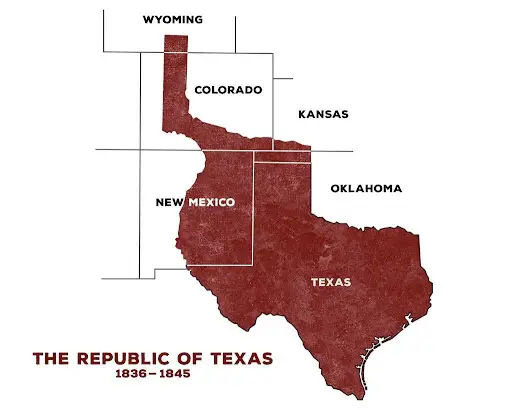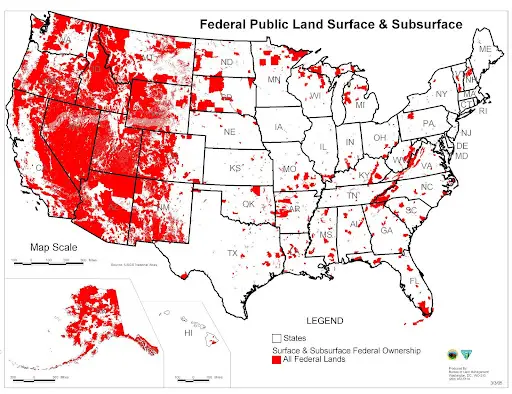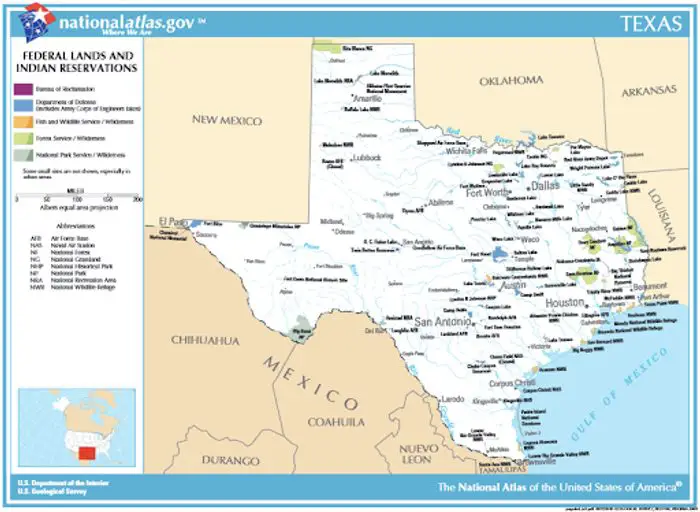Summary
•Texas has a unique history when it comes to public land ownership – because it was once its own independent republic, it retained control of its public lands (and debts) when it joined the United States.
• The state government has always viewed public land as an invaluable resource, and has funded the state using revenue from selling or leasing this land.
• Today, there is very little publicly-owned land in Texas (comprising less than 5% of the state), but what there is can be found in every region and offers opportunities for camping and seeing natural bounty.
Why Texas had to sell it’s land
A common question from recent arrivals to Texas – especially from Western states like California and Colorado – is “Where are the national parks?” Around 30% of the country is federally owned land, comprising not only national parks and monuments but fisheries, mines, and grazing lands. Texas’ western neighbor, New Mexico, has over 24 million acres of federal land, about a third of its area. Texas, meanwhile, has just over 3 million: about the same as Arkansas, which is only a fifth the size. In fact, over 95% of the state is privately owned, with only 5% held by the public.
An answer to the question above requires some history, because the circumstances of Texas’s admission to the United States were unique. Texas entered the Union in 1845, not as a territory or purchase but as an independent republic – one with over 200 million acres of public land and $10 million in war debt. Reluctant to take responsibility for this debt, the US congress stipulated that Texas would retain its public lands upon annexation, as well as responsibility for its debts.
The Compromise of 1850
The state legislature was able to discharge these debts in the Compromise of 1850, which established the current state borders. The state ceded about a third of its northern and western territories in exchange for the $10 million dollars it owed. This left the state with about 100 million acres of public land. The state government viewed this land as an invaluable and inexhaustible resource and continued the practice of funding the state government with land. The Texas state capitol building, for example, was paid for entirely with land: 3 million acres in the Panhandle, valued at 55 cents an acre.

The Permanent School Fund
By far the biggest expenditure, however, was the Permanent School Fund (PSF), an endowment that is still a primary source of funding for Texas schools and colleges over 150 years after its establishment. Originally endowed with 4 million acres of land and $2 million, the PSF today is nearly $50 billion. The bulk of this money comes not from the sale of public land — the state had sold all 200 million acres of its public land by 1900 — but from oil and gas drilling on the appropriated land.
Texas owes its economic success to its land: not just the crops and resources produced by the land, but the state’s ability to pay with land when cash was scarce. On the other hand, the cost has been tremendous with the loss (over the past 175 years of statehood), of public lands with a total area twice the size of Spain. Today, there are comparatively few parcels of public land remaining with less than 5% of the state left in the public coffers.
What’s left of public land in Texas today

Still, in a state as large as Texas, 5% is quite a bit, and if Texas’ public lands are comparatively rare, they’re also worth seeking out. From Big Bend in west Texas to Padre Island on the Gulf coast, every region of the state has a few parcels of public land, some quite extensive. These are usually open to the public, and many allow free camping. They’re great opportunities to see the natural bounty that has nourished the state for hundreds of years – and to see why so many people want to own a piece of it.
Sources:
Ballotpedia. “Federal land ownership by state”: https://ballotpedia.org/Federal_land_ownership_by_state
Texas General Land Office. “History of Texas Public Lands.” https://www.glo.texas.gov/history/archives/forms/files/history-of-texas-public-lands.pdf
Texas Education Agency. “Texas Education and the Permanent School Fund.”
